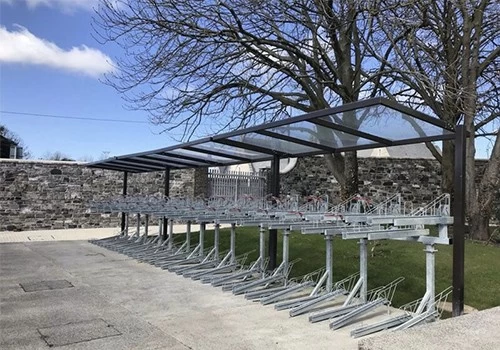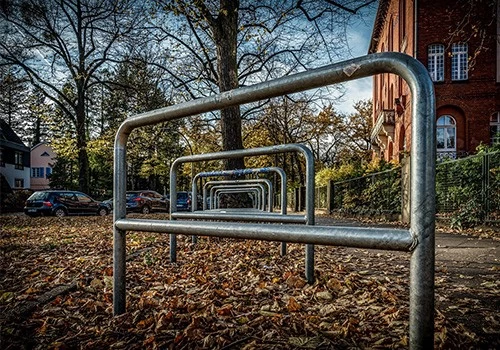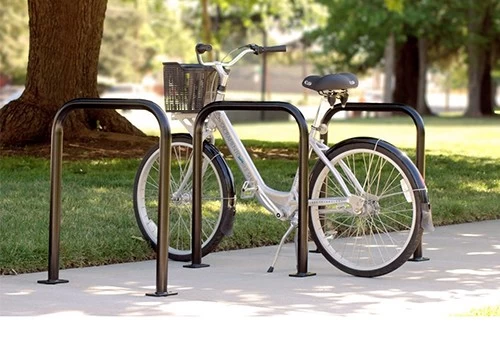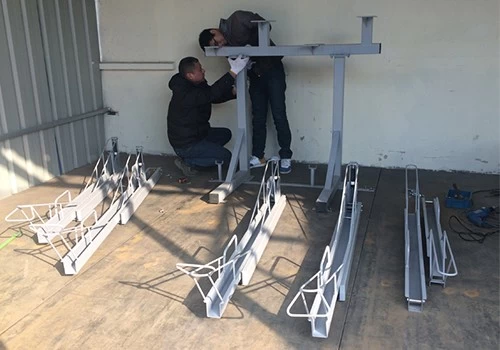Specifications
Model Number : PV-SC-001
Type: Bike parking and storage
Color:Yellow,Black,Green,Red,or Customized.
Style : both indoors and outside
Material : carbon steel
Loading: According to customer need
Size :195*23.2*75cm,200.55*23.2*75cm,or Customized.
Finish: hot-galvanized
Specifications
Model Number : PV-0081-01
Type: Bike parking and storage
Color:silver
Style : both indoors and outside
Material : carbon steel
Loading: According to customer need
Size :Height 1463mm, Depth 1114mm
Finish: hot-galvanized
Model Number : PV-0081-01
Type: Bike parking and storage
Color:Black
Style : both indoors and outside
Material : carbon steel
Loading: 2-10 bikes (According to customer need)
Size :Height 1463mm, Depth 1114mm
Finish: hot-galvanized
Model No.: PV-H1
Size: w605*D400*H330mm
Specification: Round tube:¢16*1.2mm
Finish: Power coated
Net Weight: 1.6 kgs
Packing size:6pcs/ctn
MOQ: 100pcs
Model Number : PV-0024-01
Material : carbon steel/stainless steel
Loading: according customer space size,we can design according the size
Size : W1977*D1130(depend on your parking space)*H2500mm
Finish: Powder coated ,hot-galvanized/electric polish
Packing size :2000*2000*2500mm(40 parking space )
Powder coated ,hot-galvanized/electric polish
Product number:PV-0046-01
Material:carbon steel
Specification:10.2*59*28CM or Customized.
MOQ:100PCS
Port:Shanghai
Trademark:PV
Model Number : PV-0081-01
Type: Outdoor Bike Parking Rack
Style : both indoors and outside
Material : carbon steel
Loading: 2-10 bikes (According to customer need)
Size :170.5*116*148CM
Finish: hot-galvanized
Model Number : PV-0055-01
Type: compact flat pack /slot
Color:black / silver /yellow/optional
Style :Outdoor/indoor
Material : carbon steel/ stainless steel
Capacity : park 6 bikes
Size : L1400*W1054*H840mm
Net weight :38KG
Finish: powder coating / hot galvanized /elctropolishing
Packing size :1490*860*160mm 1pcs/ctn
Product Name: Multi-Capacity Horizontal Two Tier Bike Parking Rack
Material: Carbon Steel
Finish: Powder coated
Post: 80mm * 80mm thickness: 3mm
Steel plate: thickness: 2mm
Dimension: 1325*1890*1830mm
Weight: 370 kg/set
Model: PV-0067-01
Material: stainless steel 304
Pipe: 50 mm* 2.5 mm
Size: 900*700 mm(L*W)
Surface treatment: polishing

In recent years, as cities embrace sustainable transportation and individuals prioritize eco-friendly commuting, the demand for reliable bicycle parking solutions has surged. Bicycles have evolved from mere leisure tools to essential daily transportation, making well-designed parking infrastructure a critical component of urban planning, business operations, and community development. However, there is no one-size-fits-all solution when it comes to bicycle parking racks. Every site has its unique characteristics, challenges, and requirements, which is why tailored parking solutions have become indispensable. This blog explores the art and science of building bicycle parking racks that adapt to specific site needs, ensuring functionality, safety, and efficiency.
Before delving into the specifics of customization, it is essential to understand why tailored bicycle parking matters. A poorly designed or ill-fitted parking rack can lead to a host of problems: underutilization of space, increased risk of theft or damage to bicycles, user frustration, and even negative impacts on the aesthetics of a site. Conversely, a thoughtfully customized parking solution enhances user experience, maximizes space efficiency, improves security, and integrates seamlessly with the surrounding environment.
According to a study by the League of American Bicyclists, well-designed bicycle parking can increase bicycle usage by up to 30% in urban areas, as cyclists feel more confident leaving their bikes in secure, convenient locations. This statistic underscores the transformative power of tailored parking solutions—not only do they serve practical needs, but they also encourage more people to adopt cycling as a viable transportation option. Whether for a corporate campus, a university, a residential complex, or a public transit hub, the key to successful bicycle parking lies in customization that aligns with unique site requirements.
The foundation of any tailored bicycle parking solution is a comprehensive site assessment. This process involves analyzing multiple factors to determine the optimal design, placement, and capacity of the parking racks. Without a thorough evaluation, even the most well-constructed racks may fail to meet user needs or fit the site’s constraints. Here are the critical elements to consider during a site assessment:
1,Space Dimensions and Layout
The first step is to measure the available space and map its layout. This includes noting the length, width, and height of the area, as well as any fixed obstacles such as walls, columns, trees, or utility poles. For example, a narrow alleyway between two buildings will require a different rack configuration than an open plaza. The layout also influences traffic flow—racks should be placed to avoid blocking pedestrian paths, entrances, or emergency exits. Clearance requirements must be considered: a minimum of 3 feet (0.9 meters) of space should be maintained around the racks to allow easy access for cyclists parking and retrieving their bikes.
2,User Demand and Traffic Patterns
Understanding who will use the parking racks and when is crucial for determining capacity and placement. A university campus, for instance, may experience peak demand during class hours, with hundreds of students needing parking spots. In contrast, a residential complex might have steady but lower usage throughout the day. Traffic patterns also matter: racks should be located along common routes that cyclists take, such as near building entrances, bike lanes, or public transit stops. Observing where cyclists currently park their bikes (even informally, such as against railings or trees) can provide valuable insights into user preferences and high-demand areas.
3,Environmental Conditions
Environmental factors play a significant role in material selection and rack durability. Sites exposed to harsh weather—such as coastal areas with salt spray, regions with heavy rainfall, or locations with extreme temperature fluctuations—require racks made from corrosion-resistant materials. Sunlight exposure might also influence design; in hot climates, integrating shade structures with parking racks can enhance user comfort. Additionally, areas prone to high winds may need sturdier anchoring systems to prevent racks from tipping over.
4,Existing Infrastructure and Aesthetics
The parking racks should complement, not compete with, existing infrastructure and architectural styles. For a historic district, a sleek, modern rack design might feel out of place, while a campus with contemporary buildings could benefit from a more minimalist aesthetic. Racks should also align with other site features, such as landscaping, lighting, or signage. For example, integrating racks with existing lighting ensures visibility during evening hours, enhancing security. In some cases, racks can even become a design feature that adds to the site’s visual appeal, such as custom-shaped racks that reflect a brand logo or local culture.
5,Regulatory and Accessibility Standards
Compliance with local regulations and accessibility guidelines is non-negotiable. Many cities have specific codes governing bicycle parking, including requirements for the number of spaces based on building occupancy, rack dimensions, and anchoring methods. Accessibility is another critical consideration: racks must be usable by cyclists with disabilities, including those using adaptive bikes or mobility aids. This may involve designing racks with lower heights, wider spacing, or clear pathways for wheelchair access. Failing to meet these standards can result in fines, legal issues, or exclusion of users with specific needs.

Every site has unique characteristics that demand tailored parking solutions. What works for a bustling downtown commercial area will not be suitable for a quiet suburban neighborhood. Below are examples of how customization addresses the distinct requirements of various site types:
1,University and School Campuses
Campuses are high-traffic areas with diverse users, including students, faculty, and staff, all with varying schedules and bike types (from road bikes to mountain bikes and e-bikes). Demand peaks during class times, so capacity is a key concern. Custom solutions for campuses often include high-density rack configurations, such as double-sided racks or tiered systems, to maximize the number of parking spots in limited space.
Location is also critical—racks should be strategically placed near dormitories, lecture halls, libraries, and dining facilities. Security is a top priority, so many campuses opt for racks with locking points that accommodate U-locks and chain locks, paired with surveillance cameras or bike lockers for high-value e-bikes. Aesthetics matter too; racks can be customized with school colors or logos to reinforce campus identity. For example, a large university in the Midwest worked with a parking solutions provider to install powder-coated racks in the school’s signature blue, arranged in clusters near academic buildings to ensure easy access during busy class changes.
2,Commercial and Corporate Sites
Corporate campuses and office buildings require bicycle parking that balances functionality with professionalism. Many companies now offer cycling incentives, such as bike-to-work programs, making reliable parking a necessity to attract and retain employees. Custom solutions here often focus on convenience and security. Racks may be located near employee entrances or adjacent to bike storage rooms with showers and changing facilities.
For businesses in urban areas with limited space, vertical or wall-mounted racks can be a space-saving option. Aesthetics are important in maintaining a corporate image, so sleek, modern designs in materials like stainless steel or powder-coated aluminum are popular. Some companies also integrate branding into the racks, such as laser-cut logos or custom color matching to align with corporate identity. A tech company in California, for instance, installed curved aluminum racks outside its headquarters, designed to complement the building’s modern architecture while providing secure parking for over 50 bikes.
3,Residential Complexes
Residential sites, including apartments, condos, and townhomes, require bicycle parking that is accessible, secure, and unobtrusive. Residents need convenient access to their bikes, often at all hours, so racks should be located near building entrances or in covered areas. Security is paramount to prevent theft, so options like enclosed bike rooms with key fob access or ground-mounted racks with heavy-duty locking mechanisms are common.
Space constraints can be a challenge in urban residential areas, so compact designs that fit into small courtyards, garages, or hallways are ideal. For family-friendly complexes, racks should accommodate children’s bikes and cargo bikes, with lower crossbars for easy access. A luxury apartment building in a major city, for example, opted for custom-built wooden and steel racks that blend with the courtyard landscaping, providing covered parking for 30 bikes while maintaining the area’s upscale appearance.
4,Public Transit Hubs
Train stations, bus terminals, and light rail stops serve as critical connection points for commuters who combine cycling with public transit. These sites require high-capacity, durable parking solutions that can handle heavy daily use. Custom racks at transit hubs are often designed for quick and easy access, allowing commuters to park and retrieve their bikes efficiently during rush hours.
Weather resistance is essential, as racks are exposed to the elements year-round. Many transit agencies choose hot-dip galvanized steel racks for their durability and corrosion resistance. High-visibility designs, with bright colors or reflective strips, help users locate parking quickly, even in low light. Some hubs also integrate bike repair stations adjacent to racks, adding value for commuters. A major transit authority on the East Coast installed a series of wave-style racks at its busiest stations, capable of holding 10 bikes each, with clear signage and lighting to enhance usability during morning and evening commutes.

The choice of materials is a cornerstone of custom bicycle parking rack design, directly impacting durability, maintenance, aesthetics, and cost. Different materials offer distinct advantages, and the selection should be based on the site’s environmental conditions, usage intensity, and aesthetic goals. Here are the most common materials used in custom parking racks, along with their benefits and ideal applications:
1,Steel
Steel is a traditional and widely used material for bicycle parking racks, valued for its strength and affordability. Carbon steel, in particular, provides excellent durability, making it suitable for high-traffic areas with heavy use. However, untreated steel is prone to rust, so it requires protective coatings to withstand moisture and corrosion. Powder coating is a popular option, offering a durable, chip-resistant finish in a wide range of colors. Hot-dip galvanizing is another effective treatment, where the steel is dipped in molten zinc to create a corrosion-resistant layer—ideal for outdoor racks in rainy or coastal environments.
Steel racks are versatile and can be fabricated into various shapes, from simple grid designs to more intricate patterns. They are ideal for sites where strength is a priority, such as public transit hubs or busy commercial areas. A downside is that steel is heavier than other materials, which can make installation more labor-intensive, but this weight also adds stability, reducing the risk of theft or tipping.
2,Aluminum
Aluminum is a lightweight alternative to steel, offering several advantages for custom racks. It is naturally resistant to corrosion, making it a great choice for outdoor use in humid or coastal climates without the need for extensive protective coatings. Aluminum racks are easier to transport and install due to their lighter weight, which can reduce installation costs.
While aluminum is not as strong as steel, it is still durable enough for most applications, especially when reinforced with thicker gauge material. It is also highly malleable, allowing for creative designs, such as curved or angular shapes, that enhance aesthetics. Aluminum racks are often chosen for residential complexes, campuses, and commercial sites where a modern, sleek look is desired. They can be powder-coated in custom colors to match site aesthetics, though their natural silver finish is also popular for a minimalist appearance.
3,Stainless Steel
Stainless steel is the premium choice for bicycle parking racks, offering unmatched durability and corrosion resistance. It contains chromium, which forms a protective oxide layer that prevents rust and staining, even in harsh environments like coastal areas or locations with heavy salt use in winter. Stainless steel is also low-maintenance, requiring little more than occasional cleaning to maintain its appearance.
These racks are ideal for high-end applications where aesthetics and longevity are critical, such as luxury residential buildings, upscale commercial districts, or historic sites where preservation of appearance is important. Stainless steel can be polished to a high shine or brushed for a more matte finish, and it can be fabricated into complex designs. The main drawback is cost—stainless steel is more expensive than steel or aluminum—but its longevity and low maintenance needs often justify the investment over time.
Beyond material selection, the design of custom bicycle parking racks must address usability, security, and compliance with standards. A well-designed rack not only fits the site but also provides a positive experience for users while protecting their bikes from theft and damage.
1,Security Features
The primary function of a bicycle parking rack is to secure bikes, so design must prioritize locking points. Each rack should have multiple points where cyclists can attach their locks, such as horizontal bars or loops that allow for securing both the frame and wheels. Racks should be anchored securely to the ground using concrete footings or bolts to prevent them from being lifted or moved. For high-risk areas, racks can be paired with additional security measures, such as bike lockers, surveillance systems, or motion-activated lighting.
2,User-Friendliness
A rack that is difficult to use will discourage cyclists from parking there. Design should allow for easy access, with enough space between bikes to avoid overcrowding. Racks should accommodate different bike sizes, from small children’s bikes to large e-bikes, with adjustable or versatile designs. The height of the rack is also important—bars should be low enough for most users to reach comfortably while standing, typically between 18 and 24 inches (45 to 60 centimeters) from the ground.
3,Compliance with Standards
Adhering to industry standards ensures that racks are safe, accessible, and functional. Organizations like the Association of Bicycle and Pedestrian Professionals (ABPP) and local building codes provide guidelines on rack dimensions, spacing, and anchoring. For example, racks should be at least 2 inches (5 centimeters) in diameter to prevent cutting or bending, and each bike should have a minimum of 2 feet (0.6 meters) of space along the rack to avoid overcrowding. Accessibility standards, such as the Americans with Disabilities Act (ADA), require that a portion of parking spaces be accessible to users with disabilities, with clear pathways and racks designed for easy use with adaptive bikes.
4,Aesthetic Integration
Custom design offers the opportunity to integrate racks into the site’s overall aesthetic, rather than treating them as an afterthought. Racks can be shaped to complement architectural features, incorporate branding elements, or reflect local culture. For example, a rack in a coastal town might feature wave-like curves, while a university rack could include the school’s mascot in its design. Color is another tool for integration—custom powder-coating allows racks to match building exteriors, landscaping, or brand colors, creating a cohesive look.

Even the best-designed custom bicycle parking racks will underperform without proper installation and maintenance. These steps ensure that the racks remain safe, functional, and attractive over time, maximizing their lifespan and return on investment.
1,Professional Installation
Proper installation is critical to the stability and security of the racks. The method depends on the rack type and the surface where it will be installed. Ground-mounted bike racks require secure anchoring to concrete, asphalt, or other solid surfaces using expansion bolts or concrete footings. For areas where permanent installation is not possible, such as paved surfaces that cannot be drilled, portable racks with weighted bases can be used, though these are less secure than fixed options.
Installation should be performed by experienced professionals who understand the site’s conditions and the rack’s requirements. They will ensure that the racks are level, properly aligned, and anchored to withstand use and potential theft attempts. Post-installation checks should verify that all bolts are tight, and the racks are stable before opening them to users.
2,Maintenance Best Practices
Regular maintenance is essential to keep custom racks in good condition. For steel racks, inspecting for rust and reapplying protective coatings as needed can prevent corrosion. Aluminum and stainless steel bike racks require less maintenance but should be cleaned periodically to remove dirt, grime, and salt buildup. Moving parts, such as hinges on foldable racks, should be lubricated to ensure smooth operation.
User feedback is also part of maintenance—monitoring how the racks are used can identify issues like overcrowding, poor accessibility, or security vulnerabilities. Adjustments, such as adding more racks or relocating them, can be made based on this feedback to better meet user needs. A maintenance schedule should be established, with regular inspections and repairs to address minor issues before they become major problems.
Creating tailored bicycle parking racks requires expertise in design, engineering, and site assessment—skills that most organizations do not have in-house. Partnering with a reputable custom parking solutions provider ensures that the entire process, from site evaluation to installation, is handled professionally. These providers have the experience to navigate challenges such as space constraints, regulatory requirements, and user demand, delivering solutions that are both functional and aesthetically pleasing.
A good provider will start with a collaborative consultation, listening to the client’s needs and conducting a thorough site assessment. They will then develop custom designs, providing 3D renderings or prototypes to ensure the client approves before production. Fabrication is done using high-quality materials and precise manufacturing techniques, followed by professional installation and post-installation support. This end-to-end approach ensures that the final product meets all site requirements and user expectations.
In a world where sustainable transportation is increasingly important, tailored bicycle parking racks are more than just functional infrastructure—they are a catalyst for encouraging cycling, enhancing community spaces, and supporting a greener future. By addressing unique site requirements through careful assessment, custom design, and quality materials, these racks provide safe, convenient, and attractive parking solutions that meet the needs of users and fit seamlessly into their environments.
Whether for a bustling campus, a corporate headquarters, a residential complex, or a public transit hub, the value of customization cannot be overstated. It ensures that every square foot of space is used efficiently, that security and usability are prioritized, and that the racks contribute positively to the site’s aesthetics. As more communities and organizations recognize the importance of cycling infrastructure, partnering with experienced providers to create tailored parking solutions will be key to building a more bike-friendly world.
Investing in custom bicycle parking racks is an investment in sustainability, community well-being, and the future of transportation. By prioritizing unique site requirements, we can create parking solutions that not only serve practical needs but also inspire more people to choose cycling—one secure, well-placed rack at a time.